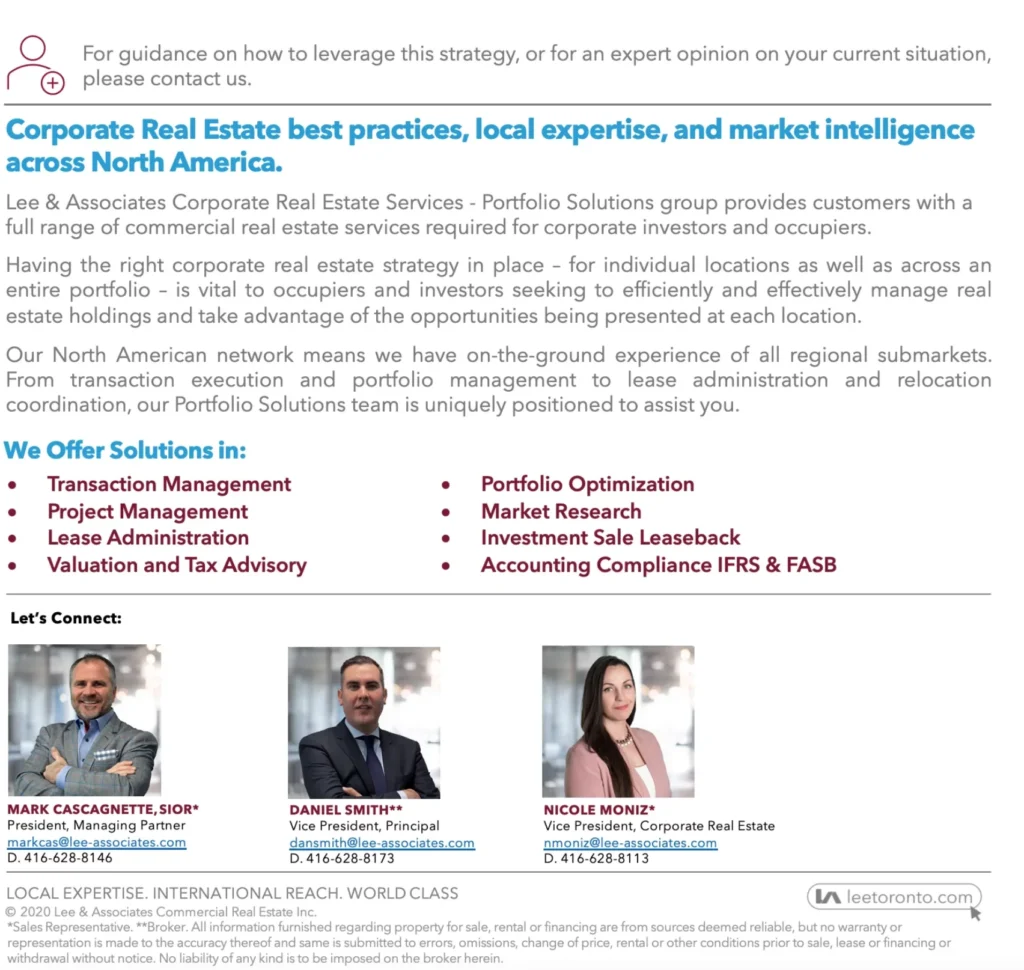THE COLLABORATIVE STRATEGIC PLANNING PROCESS
June 3, 2021

Navigating Uncertainty through Data-Driven Decisions and a Strategic Planning Process
Your company’s real estate should, in many ways, reflect the operations which it supports. In order to achieve this, corporate management should periodically implement strategic planning sessions in order to have clarity, as well as be able to quickly capitalize on opportunities in the market.
In reality, however, many businesses’ real estate decisions are executed in a compressed timeframe, meaning market conditions are often less-than-ideal. This often results in paying a premium in values or rental rates, or giving into unfavourable terms.
Today, commercial real estate is seeing a divergence of two groups of asset classes. First, industrial properties are generally seeing explosive demand due in large part to e-commerce and online grocery sales. Second, office and retail are facing an existential crisis due to the pandemic.
That said, opportunities in commercial real estate markets across the world will be abundant as we emerge from stay-at-home orders and trickle back into the office, malls, brick-and-mortar stores, and begin to travel. The events that have transpired over the past 18 months are but another example of a changing business landscape whereby those with the data and long-term planning in place are able to nimbly adapt and protect their core business from adversity.
In our first part, we examined Strategic Planning, the questions it seeks to understand, and the benefits of conducting the process. In this issue, we will take a look at the Collaborative Strategic Planning Process, and how it can help you optimize your real estate holdings and portfolio, as well as navigate uncertainty through data-driven decisions.
The Collaborative Strategic Planning Process
1. Collect Data
Making strategic decisions entails having a clear understanding of where your business, its assets, and its commitments currently stand. Management should aggregate as much data as possible pertaining to both your real estate holdings and portfolio, as well as the business’ overall financial metrics.
2. Understand Business Objectives
A company’s real estate portfolio should, in many ways, reflect the direction of the operations which it supports. Analyzing the business’ financial position, its mission, market presence, and long-term plans is a crucial step in the overall process.
3. Determine Optimal Real Estate Needs
Based on your business’ objectives, a corporate real estate advisor can help you validate your assumptions and confirm your true real estate needs.
4. Analyze Portfolio, Leases, Valuations, Financial Position
Once you have obtained your true ‘north star,’ your CRE advisor can look through all real estate-specific information, including but not limited to, your owned assets, lease commitments, debt, and cashflow, to identify real estate-related risks and opportunities.
5. Identify Real Estate Opportunities
Upon completion of the process up until this point, your CRE advisor will be able to provide recommendations on leveraging one of the following: acquisition, leasing, lease termination, lease renewal or renegotiation, consolidation, disposition, sale-leaseback, relocation, new development or design-build.
For each identified opportunity, your CRE advisor can provide a shortlist of options, as well as a strategy for both individual assets and the broader portfolio.
6. Execute Gameplan
Now that you have a robust, data-driven gameplan, you are ready to pull the trigger on opportunities already identified, or as they arise. Here, an experienced CRE advisor can provide you with market intel and insight that will help proactively manage expectations, as well as produce competitive pricing, compressed timelines, and favourable terms.
7. Ongoing Reporting and Optimization
As you begin executing transactions – and after you achieve the objectives you initially set out to – it is important to continue your data collection for ongoing reporting and further portfolio optimization. Your CRE advisor can assist with the periodic maintenance, as well as report on sudden or forecast changes in the market, so that you and your team can avoid any unexpected or costly scenarios.
Summary
Overall, Tenants and Landlords of commercial space are constantly looking for opportunities to improve flexibility, minimize costs, and increase the values of their real estate holdings and portfolios.
Strategic market planning, acquiring, disposing, consolidating, renewing, renegotiating, and relocating are tools that may provide immediate rent relief and capital injections or longer-term assurances in costs that enable more accurate forecasting. They can also give corporate management the confidence they need to meet their organizational objectives. Given the uncertainty and rapidly shifting commercial real estate market, it may be prudent to explore all pertinent options available in order to make the best decision possible.
